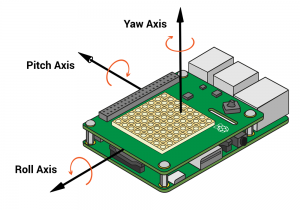In our previous post on visual field construction we discussed motion and how motion feed-forward may be used to create a stable visual field. Our body has such sensors in the head and their is no question that they play an important part in visual processing.
From the Wikipedia article on the Inner Ear: “The vestibular system of the inner ear is responsible for the sensations of balance and motion. It uses the same kinds of fluids and detection cells (hair cells) as the cochlea uses, and sends information to the brain about the attitude, rotation, and linear motion of the head. The type of motion or attitude detected by a hair cell depends on its associated mechanical structures, such as the curved tube of a semicircular canal or the calcium carbonate crystals (otolith) of the saccule and utricle.”
For the Raspberry Pi there is a motion sensor board available called the “Sense-Hat“. It contains a variety of accelerometers, gyros and other sensors that should be able to feed motion information into our visual field construction algorithms to give us a stable visual field and even additional information to allow us to construct a 3D-space visual field.

Unfortunately, results to-date using the Sense-Hat are disappointing and not reliable. The motion readouts and information is not what was expected. Additional work is required to determine what calibration or other processing steps might be required to get acceptable motion information. We’ll continue to work on this as having decent motion sensing would allow many new and interesting experiments for the Eye.